Reproduction of violets (Saintpaulia): methods and advice of experts
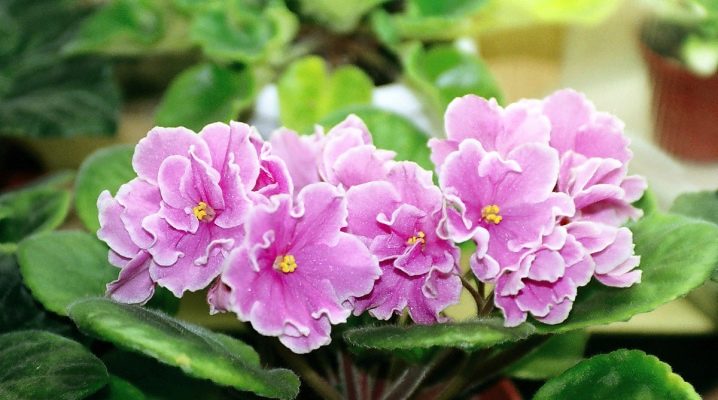
Cultivating indoor crops, sooner or later the question of reproduction of a favorite plant will arise before every gardener. This also applies to indoor violets (Saintpaulias), which very often adorn window sills in apartments and houses. Today, there are several of the most effective ways to get a new blooming crop at home.
When is the best time to propagate violets?
Flowering herbaceous plants of the Gesneriaceae family are combined into a separate genus called Saintpaulia. Florists call these cultures the uzambar violet, which in the common people is called simply a violet. Saintpaulia has long been cultivated as an ornamental indoor culture. Today, many varieties of this plant have been artificially obtained, the bulk of which are represented by hybrids grown during the crossing of interspecific crops, as well as other types of violets. In light of the great popularity of the plant, very often experienced and novice florists set themselves the goal of propagating their favorite flower on their own... To solve this problem, there are several methods that can be implemented at home.
However, the uzambara violet is a rather capricious flower, therefore, before breeding, you should create optimal conditions for it. A suitable indoor climate will allow the grower to breed at any time of the year, without being tied to a specific season. Professionals who have been actively involved in growing violets at home for several years still recommend choosing the spring-summer months to get new crops. As a rule, the violet takes root rather quickly, forming lush rosettes. The choice of this or that method of plant breeding will depend on the personal preferences of the owner of the crop, as well as on the variety of violets.
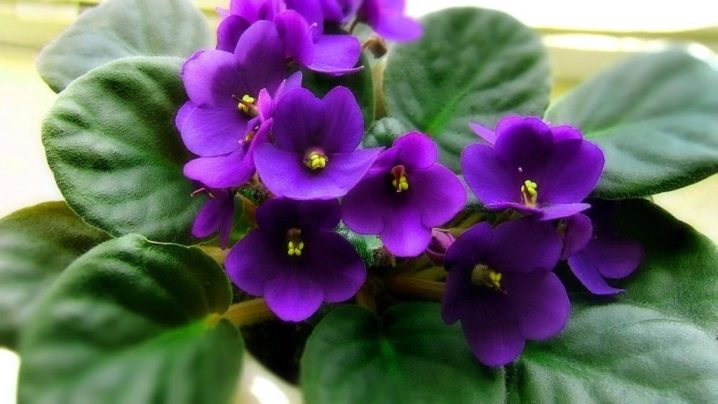
A competent planting of the material obtained will also guarantee a healthy plant.
The necessary conditions
There are several fundamental criteria that will allow you to successfully reproduce violets.
Time
In addition to tips to carry out work in the warmer months, it is worth noting that getting new flowers will be more correct to deal with during the day. The presence of long daylight hours, which becomes minimal in winter, is an additional growth stimulator for young crops. In addition, after a dormant period, the mother plant begins to actively grow in the spring. The duration of daylight hours to propagate violets must be at least 12 hours. If you plan to breed the culture in December or in another winter month, it will be correct to additionally organize supplementary lighting with special phytolamps.
Indoor humidity level
Indoor violets react negatively to dry air, this is especially painful during the breeding season. And also this applies to seedlings, whether it is a leaf, a peduncle or the seeds of a plant. Violets should be planted in special mini-greenhouses, where the humidity level will be at 60%.


Temperature indicators
For a flowering crop, it is worth providing a stable reading on the thermometer.Some plant species are able to maintain their viability even at values of + 10 ° C, as well as grow at a temperature of about + 35 ° C, but the optimal air will still be warmed up to + 22– + 24 ° C.
During reproduction, the violet should be in a room where the temperature will constantly be kept from +24 to + 27 ° C.
Type of soil for reproduction
It is recommended to plant violets in soil with the presence of certain components, taken in the indicated proportions. It is important that the soil has a neutral pH level, provides good aeration for the plant root system, and is loose. To make it easier for yourself the task of selecting land for violets, planting material can be planted in a specialized soil mixture, which is sold in flower departments and shops. For more experienced florists, there is the possibility of preparing the soil with your own hands. The soil for violets will consist of the following components:
- 1 part river sand;
- 3 parts of peat with neutral acidity;
- 2 parts green moss;
- 1 part of humus;
- 1 part peat moss.
And also the composition should include 1 part of sod soil and half of charcoal, which will provide the plant with protection from bacteria and maintain the optimum moisture level of the soil mixture. At the bottom of the container for planting, expanded clay or other material of your choice is laid out as drainage.
Container for planting
For seedlings, use a small container with several holes in the bottom. The diameter of the pot should not exceed 4 centimeters. In the future, a more mature plant can already be rooted in a container, the dimensions of which will be twice the previous dimensions.
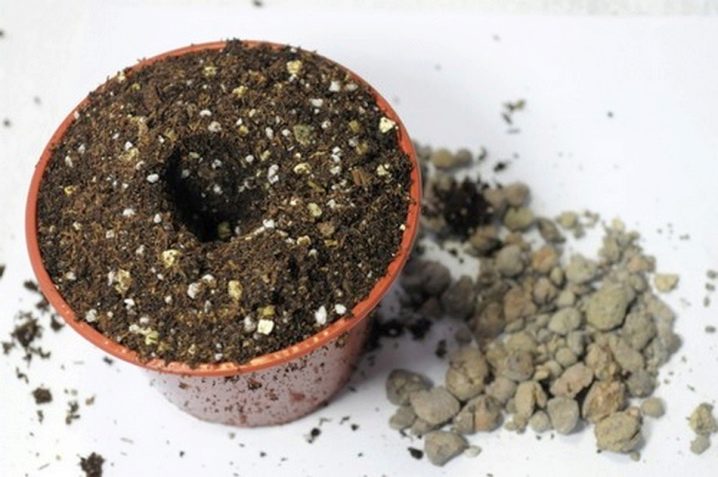
The ways
Today, flower growers use in practice several methods of obtaining violets at home.
Seeds
In order to get a healthy culture that retains all the features and characteristics of the mother plant, it is worth choosing a pair with suitable characteristics as mother flowers. It is important that both violets are completely healthy and in an active flowering phase. The task of the grower in this case is to collect pollen from one Saintpaulia, pollinating the pistils of the second flower with it. As a rule, after 3-4 months, the seed pods will fully ripen in the pollinated crop, which should be collected dry and left to be stored separately from the violet for several days.
Seed material is planted in the ground, before sowing it should be mixed with a small amount of sand. It is not worth deepening and sprinkling the seeds with earth, the soil must be moistened, and the container must be covered with glass in order to create a certain microclimate inside. The seeds should be kept in a warm place, for germination it is necessary to install a backlight for the plants. Humidification is carried out by spraying.
In the phase when the rosettes of the culture reach a height of 0.5 centimeters, they will need to be dived and planted in separate pots.

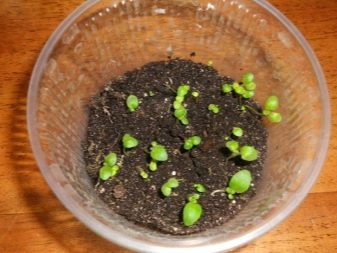
Stepsons and peduncles
The relevance of such an option for obtaining a new culture is due to the ability to preserve all the features of the mother variety in a new violet, which is extremely important for some experienced florists. The stepchildren breeding method is very often used for chimera violets. It stands out for its unusual color of flowers, which you want to keep to the maximum. The principle of working with stepchildren is reduced to the separation of side outlets, which are subsequently sent for growing in the ground by analogy with the propagation of a plant by a leaf. When leaves begin to form on the separated outlets, they are rooted in a separate small container with soil intended for violets.
As for obtaining a new culture from a peduncle, then in this case it will be necessary to separate a blossoming or already faded bud from the plant. It should be cut off from the maternal Saintpaulia with a sharp knife or with scissors, previously disinfected.To get a new flower, the bud must be used in conjunction with its stipules. Rooting takes place in a container with moss, creating a small greenhouse for the plant in it.
After the appearance of a new outlet, the violet can already be transplanted into a pot with soil mixture.
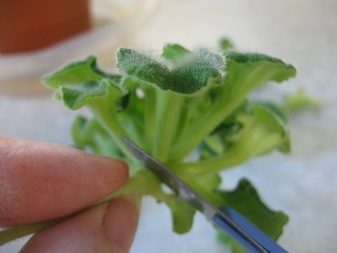
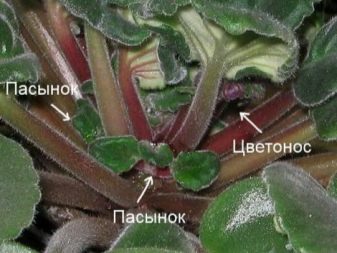
Sheet
A new violet can be obtained from a leaf that takes root in the ground or is first grown in water. Some species of Saintpaulia can be propagated using only part of the leaf plate. This method of obtaining new plants is most often resorted to, since it stands out with greater efficiency, in addition, it can be realized even by novice growers. Step by step the breeding process is as follows:
- first you need to choose the most suitable material for planting; very often the leaves are taken from an old plant, which allows you to get a similar and young flowering culture over time;
- based on personal preferences, a florist can choose the option of growing violets from a leaf in water or ground;
- as the violets grow, you will need to separate the children and plant them in the selected containers.
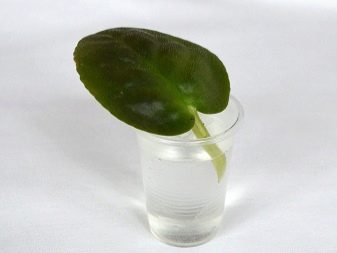

In order to choose the right leaf for work, it is worth giving preference to the middle row of the green mass of the plant. It is also necessary to focus on the appearance of the leaf - it must have a healthy and rich color, maintain elasticity, not contain spots and putrefactive processes on both sides. Very old sheets are unlikely to allow you to get a new culture with their help. Material is cut from the mother culture using a well-sharpened knife, scalpel or blade. Before starting work, the tool itself must be decontaminated with any antiseptic. The cutting angle of the sheet should be 45 degrees.
After the sheet is separated, it must be rinsed under running water, put on a napkin so that it dries well. In this state, the sheet must be kept for about a quarter of an hour. This is necessary to stop the movement of the sap, which in the future can lead to the development of rot on the plant during the growing process. Further, the place of the cut on the sheet will need to be processed with crushed coal.
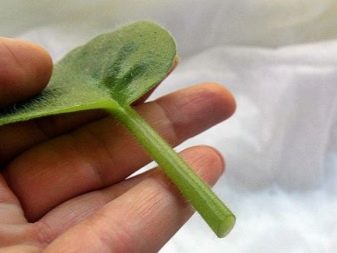
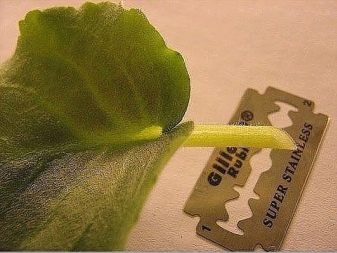
If the violet is grown in water, then work with part of the culture will need to be carried out according to a certain algorithm.
- For propagation of Saintpaulia with a leaf, it is best to use a small glass container, it would be more correct to take a jar or a glass of dark raw materials. In the collected water, you must first dissolve activated carbon.
- The leaf should be deepened into the liquid in such a way that about 1 centimeter of the plant is in the water. For ease of placement, you can place a paper sheet with a slot on top of the container. This will fix the seedling material so that it does not fall entirely into the water.
- The amount of liquid in the container must be constantly monitored, since even a short-term lack of moisture can lead to drying of the leaf. To remove violets, you should also make sure that the leaf is warm, away from drafts and direct sunlight.
- As for the timing of the emergence of roots, with proper care, the results of culture development can be observed already after 14-15 days. Once the roots have lengthened by 1 centimeter, the violet can be transplanted from the water into a pot of soil.
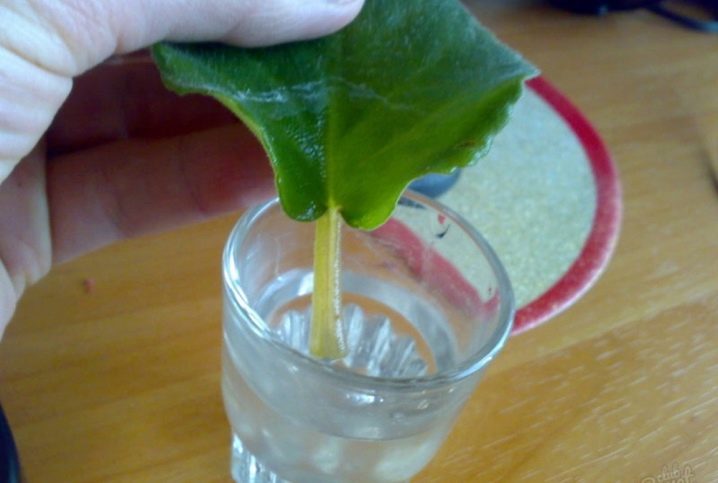
The option of removing a new violet immediately in the ground involves a florist performing such works as:
- to germinate a leaf, you will need to take a pot, the volume of which will not exceed 100 ml; as an alternative to such a small container, you can temporarily use a regular plastic cup with holes in the bottom;
- rooting will occur in soil purchased or prepared independently, but it is imperative to lay drainage at the bottom of the container - it can be expanded clay or crushed foam;
- a leaf cut in the same way as for rooting in water is kept in "Fitosporin" before planting in the soil, since this composition will disinfect the plant and eliminate the likelihood of developing fungal ailments; the remaining solution in a small amount must also be poured into the planting container;
- in the middle of the pot, it is necessary to make a small hole and deepen the sheet into it by no more than 1.5 centimeters;
- to create an optimal microclimate for violets, a glass or pot will need to be covered with a film or a jar should be placed on top; rooted material should be kept warm, without direct sunlight, and watering should be done as the soil dries.
Important! The disadvantage of working with the soil is the fact that after the rooting of the leaf it will be impossible to control the formation of the root system. However, the use of land gives almost 100% guarantee that the plant will take root.
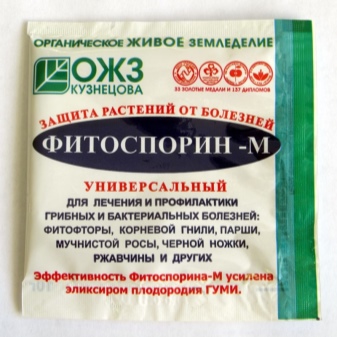
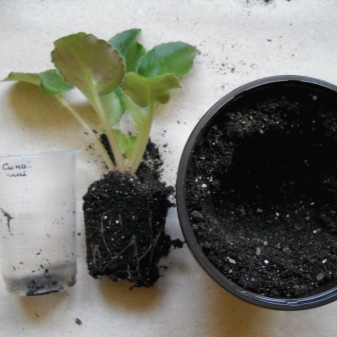
Vegetative reproduction in water or in the ground as the plant grows requires the subsequent seating of the emerging children separately. The division of the culture must be carried out after the children have formed full-fledged sheets in the amount of 4-5 pieces. The violet is separated and transplanted into a separate container. During the rooting of a young plant, do not deepen it too deeply into the soil, the growing point should always be located above the soil surface. After planting, you should control the moisture content of the soil, and also provide the children with a good level of lighting.
In addition to using a whole leaf, the violet can be propagated by a fragment. This option is usually practiced when there is a shortage of planting material or in cases where it is planned to get a new culture from a specimen that, for one reason or another, has begun to deteriorate, this is how an asexual plant reproduces. In this case, cuttings of green mass are not used, they must first be removed. The rooting part must contain at least one vein. At this point, the florist should pay attention if the division of the planting material is done independently.
A separate part of the sheet must also be allowed to dry in order to stop the movement of juices, after which the cut points are processed with crushed coal. Root part of the green mass so that the cut is completely in the ground. Moss can be used as an alternative to soil mixture for planting. As practice shows, much more violet babies usually grow from a part of a leaf than in the case of a whole leaf plate.

Care advice
As for the work related to the subsequent care of a young indoor crop, the recommendations of experienced florists differ little from the requirements regarding the cultivation of adult violets. The main tips relate to the creation of the optimal microclimate for the plant, namely:
- after transplanting the shoots into separate containers, the most suitable temperature for violets will be the range from +22 to + 24 ° C;
- the humidity level should be maintained within 50%;
- young crops for active growth and during flowering may need more watering;
- in order to maintain the root system of young violets in a healthy state, a little more perlite can be added to the soil to them, which will eliminate the risk of root rotting even with poor soil aeration.
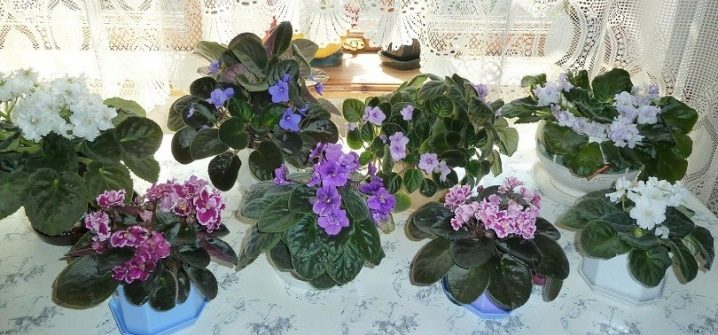































The comment was sent successfully.